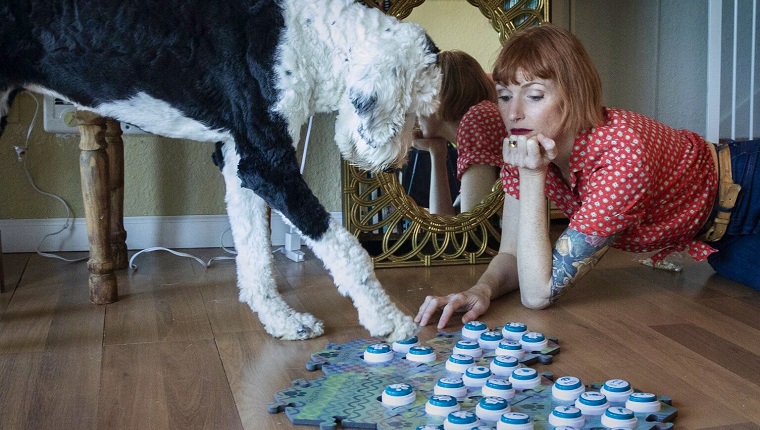Have you ever wondered, “What if my dog could talk to me?” So did Alexis Devine, dog mom, trainer, and social media manager to Bunny.
Bunny, an adorable Sheepadoodle, appears in several viral videos that you may have seen lately. In these videos, Bunny uses a soundboard with buttons to “talk” to Alexis.
Alexis and Bunny’s journey to communication has enthralled the world, garnering nearly 6 million followers on TikTok, 630,000 on Instagram, and more, not to mention many international news spotlights, making Bunny one of the most famous dogs in the world.
The superstars graciously agreed to an interview with DogTime to talk about their journey. Click the video below to see the entire interview, or you can read on for highlights and adorable pictures.
Watch DogTime’s Interview With Alexis Devine And Bunny The Talking Dog!
If you’re unable to watch the video above, or you just prefer to read, check out the interview highlights and cute pictures below.
How Did Alexis And Bunny Meet?
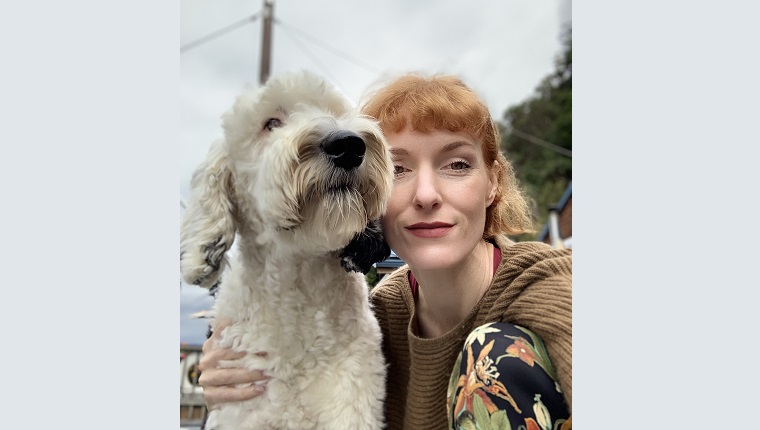
AMANDA: Let’s start at the beginning: how did you and Bunny meet?
ALEXIS: I’d been wanting a dog for a long time, but it just wasn’t the right time… finally, my husband didn’t say no, so I took it to mean yes!
I started doing a ton of research, and I found a breeder I really liked in Spokane, Washington — small, family-owned and operated — Kimra, from Kayla’s Sheepadoodles. They started breeding to get a service dog for their granddaughter, Kayla, who lost both her legs to childhood cancer. Every year, they donate dogs to service dog trainers.
I spent a lot of time on the phone with them — more than anyone ever had, they said — but they loved it.
I was lucky enough to be able to watch Bunny being born. When she was about a month old, I went to Spokane to meet all the puppies. I sat down in the whelping pen, and the mom, Domino, laid her head down on my lap.
Then Bunny, who was this little potato, the runt of the litter, came up and laid in the crook of my arm for the entire two hours. So that was the first time we met, and it was beautiful and amazing. I cried and thanked Domino for the gift she was giving me. It sounds silly, but it was magical and beautiful.
I said, “Bunny has to be mine!” When she was two months old, I flew out to get her, and we’ve been inseparable ever since.
AMANDA: That really is a beautiful story! How did you know you wanted that specific breed mix?
ALEXIS: She’s one-quarter Old English Sheepdog and three-quarters Poodle. I have some allergies, so having a “hypoallergenic” dog was important to me.
I was also really invested in the training process. I’d been doing a ton of research, and my goal from Day One was to have the most connected bond possible and the best communication.
I understood that training was a really good way to build trust and communication.
So I was looking for really smart breeds! Poodles and Border Collies seem to be the two smartest breeds, purportedly. I hadn’t had a dog since childhood, so I didn’t feel emotionally prepared for a Border Collie. But I thought a Poodle would be great, and Old English Sheepdogs are also very intelligent. That all guided my decision.
AMANDA: That’s wonderful. I’m biased, as our dog is half-Poodle, but I agree with you that Poodles are really smart.
How Do You Teach Concept Words To A Dog?
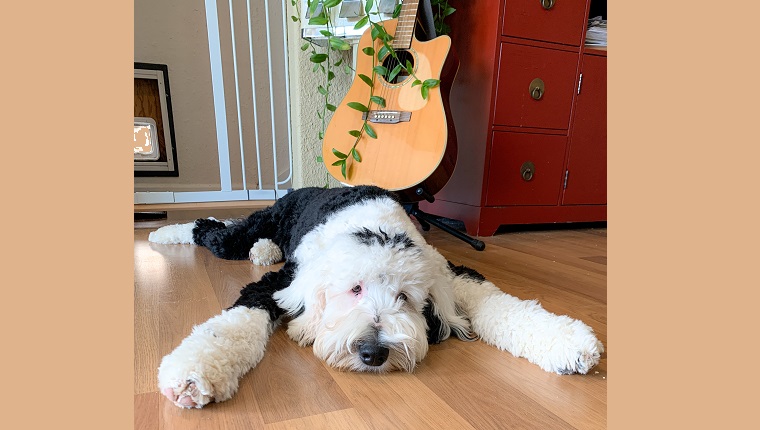
AMANDA: I’m sure you can relate to this, previous to using the buttons, but I always wish my dog could tell me if there’s something wrong, like if she’s in pain, especially. How do you teach the really difficult concepts, like pain?
ALEXIS: First of all, I would never, ever inflict pain on Bunny. When she was younger, I was getting tattoo work done, and I’d come home, let her smell it, and she’d be slightly concerned. I’d press “ouch.” When she got spayed, I pressed “ouch” a lot. When she got her paw cut on barnacles on the beach, I modeled “ouch.”
Any time I have a wound or I’m in pain, and she can sniff it, or any time she is injured, I’m able to build that association.
So many of the more complex words are just built contextually because it’s really hard to teach a word if there isn’t any context, especially to an animal.
For “concern,” I’d capture moments wherein she was seemingly expressing…
*Bunny interrupted the interview at this point by pressing “Mad. Potty.”
So if she’s mad, for example, like right now, she pressed “mad,” — in modeling that, I’d find opportunities where she seemed to be upset, and I’d use that opportunity to press “mad.”
Or if I was upset about something — and dogs are really good at reading cues — I’d use that opportunity to press “mad” and hopefully build the association that way. It’s all been putting puzzle pieces together and using guesswork and creativity on my part, but it’s seemed to work really well.
I imagine that Bunny doesn’t actually have to go potty, because when I’m in interviews, she really wants attention, and saying “potty” or “poop” is the quickest way to get it from me.
AMANDA: That is really smart of her!
ALEXIS: Yeah, a little bit manipulative!
AMANDA: It’s fascinating that people think they’re the ones conducting the experiments, but then she figures out a way to manipulate you. That’s kind of funny!
ALEXIS: I am honestly learning so much from her! I feel like she has become the teacher at a certain point, and every day, I’m like, “Whoa, this explains so much!” It’s a pretty interesting journey.
Does Bunny Know She’s Famous?
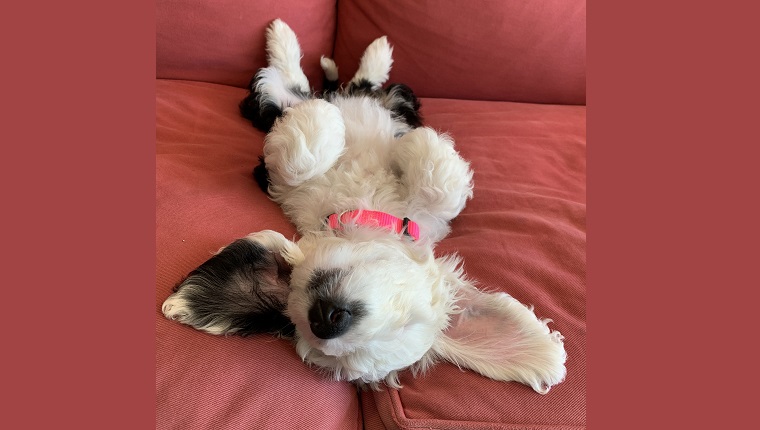
AMANDA: What is it like being so famous, and do you think Bunny knows?
ALEXIS: I don’t think Bunny knows; how would she? There are a lot of people who come up to her, but I think they would anyway because she’s super adorable.
Like a lot of dogs, she’s not super into people coming up into her face, so in that way, maybe the fame is a bit much for her. But besides that, I don’t think she has any concept. Plus, we’re in the middle of a pandemic, so we’re spending a lot of time at home, anyway.
But for me, it’s pretty surreal. I think about the numbers, and 7 million is a pretty staggering number. But we’re still going about our daily lives pretty much like normal.
My goals are still the same, to work on our communication, hang out with bunny, work on art, hang out at the beach. Things feel pretty much the same, but there’s this side bit that feels kind of weird and exciting and overwhelming.
AMANDA: Were you surprised at how interested everyone was in what you were doing?
ALEXIS: I mean, no… because I remember when I found Christina Hunger, I thought, “This is incredible. It’s staggering. It’s every child’s dream to be able to talk to animals.”
I remember that being a childhood fantasy of mine, and when I found this, I thought we had to try this out. I wasn’t really qualified to teach my dog how to speak, but once it started working, it became woven into the fabric of our daily lives.
Now, when it’s just happening throughout the day, it just feels like normal conversation.
It makes sense that other people would think, “Ah, this is incredible!” because that’s how I felt when I saw Christina’s work. But for me, it’s just so woven into the fabric of our day, that it feels like, “This is how we roll now.”
Balancing Being A Dog Mom With Scientific Experiments
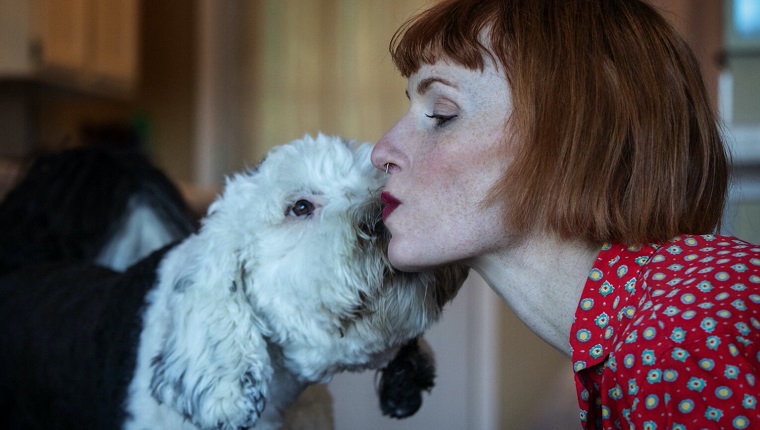
AMANDA: How do you maintain your relationship as mom and dog while also doing these scientific experiments?
ALEXIS: Thankfully, I don’t have to do any scientific experiments at all. I just get to record the data and send it to the scientists, and they’re doing all the hard work, in that regard. So my focus can remain exactly as it has: obedience training, long walks on the beach, romping through the forest, play dates with her best friends — she requests them daily!
I am very, very excited to be participating in this study, and I’m very excited that I don’t have to do any of the hard labor when it comes to the science.
AMANDA: That’s really neat. It sounds like it comes down to your mentality that this is just enhancing your relationship — that’s not what she’s there for.
ALEXIS: That’s exactly right. A priority I had was to communicate with her as well as possible without the buttons. It was just this adjunct, fun thing we were going to try to see if it worked, in addition to all this other fun stuff I had planned for us. It did, and she seems to really enjoy using them to communicate with me.
When we’re out and about, people will ask me if she gets stressed out not having the buttons with her, and I don’t think so at all. We’ve got great communication.
I’ve learned to read her cues really well, and she’s learned to read my cues really well, and we work on communicating a lot without the buttons.
So it’s just an addition to this really beautiful communication that we’ve already developed.
Did You Initially Intend to Be Part of a Scientific Study?

AMANDA: You’ve mentioned you’re part of a scientific study. Was that your initial intent, or did that come later?
ALEXIS: That came later. When I started, I was just thinking, I’m going to see how far I can go with this, based on the blogs I read from Christina Hunger.
I think about six months into the journey, I came into contact with Leo Trottier, who was developing a specific AAC (Augmentative and Alternative Communication) device and looking for beta testers. I thought, “Yeah, I want some science-informed protocol that I can follow and see if it takes us further, if it can help inform the buttons I add.”
So I started using the system he was developing, and we’ve been using it ever since. I really think it has made a difference.
When we first started, I had the buttons all on a plywood board, in no distinct order. I’d just think of a word she wanted and I’d put it in a row.
When I started working with Leo, he suggested we organize the words according to the Fitzgerald key, which was developed by Edith Fitzgerald in the early 19th century to help deaf children learn syntax and sentence structure.
Each of the types of words are grouped into hextiles, so Bunny is more easily able to compartmentalize where they are and memorize where they are through muscle memory.
Organization Is Key
AMANDA: Could you please tell us a bit more about how you organize Bunny’s buttons?
ALEXIS: With the Fitzgerald key? Yes. If you purchase the hextiles through FluentPet, they have a guide on how to organize them, but ostensibly, each hextile will have its own word type.
You’ll have the “people” tile, the “action” tile, the “places” tile, the “things” tile. I’ve got “Mom, Dad, Bunny, Cat, Beacher, Tango, Selena” on one tile. I’ve got all of her toys on another tile.
You cluster them into like objects, so instead of having to think about finding this one word in a mass of buttons, she can think, “This is the tile where this word exists, and this is the button within this one tile.” It seems to be very very helpful for Bunny.
Is Bunny Just Smarter, Or Can Other Dogs Learn?
AMANDA: I know every dog has the potential to learn this, but why do you think Bunny is particularly talented at using the buttons?
ALEXIS: I think every dog is different. Some people are using treats; some people don’t have as much time to dedicate as I do.
I think one of the reasons we’re so successful is that one of my primary goals was communication and connection before the buttons, so I think that really comes through. Any learner, any animal, has to be really motivated to learn this method, because it’s not natural.
Like, being in a foreign country, you have to learn the language to survive. But Bunny doesn’t have to use the buttons; I already understand her “language” to the best of my ability.
So working on that connection and that drive to connect and communicate is what’s going to empower your learner to want to use the buttons to communicate with you. I think it’s all about connection and relationship, really.
Advice For Beginners Who Want To Try With Their Dogs
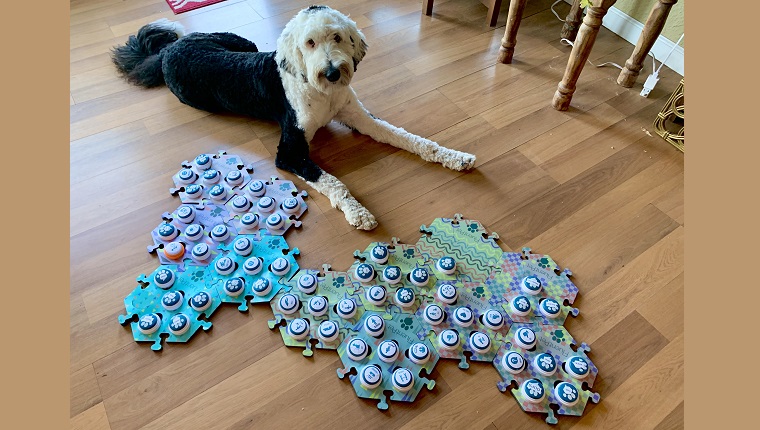
AMANDA: Would you have advice for people — people like me! — who want to start using this method with their dogs? It’s almost overwhelming to look at Bunny using 80 words and then think, “How do you even start?”
ALEXIS: Yeah! So don’t compare your learner to Bunny. If you’re not using any buttons, that’s a really unfair comparison.
Just think — what are things that are highly motivating to your learner? Is going outside really motivating? Is getting petting or cuddles highly motivating? If they are, those are going to be things that are fairly simple to get a connection going in their mind.
So just start with one button. I don’t recommend using a “treat” button because it can be too highly motivating, and it can build the connection that any button equals food, and you don’t want that because that will delay their building the actual association for whatever that word is.
But all dogs are different, and some dogs aren’t motivated by food at all. But for example, “outside” — just start with that one button by the door, and every single time you go outside, press it, and you’ll build the association.
Paw-targeting exercises are a really great way to get them comfortable with putting their paw on something and understanding that that’s a behavior to offer. There are tons of tutorials online.
I started with Tupperware exercise: show them a treat, putting a treat under the lid, and then they’ll probably start pawing at it. As soon as they use their paw, you reward them with a treat.
You do that a bunch of times, eventually, you can do it without a treat inside. They see the Tupperware on the ground, they start pawing it, you reward them every time, then you can add a verbal cue, like “paw.”
Then you can move over to the button, and then even without the treats, they’ve learned to use the buttons with their paw. Then, you can start building the association with the word itself.
You can do this all at the same time. You can have the button by the door, be modeling it, and working on the paw-targeting simultaneously. If you’re doing that, they’re much more likely to try using their paw on the button themselves.
How Does Bunny Communicate With Others?

AMANDA: I know Bunny is very social and loves her dog friends. It sounds like she loves people, too.
ALEXIS: Some of them!
AMANDA: Do other people in your life interact with Bunny in the same way you do? Do they use buttons with her?
ALEXIS: Not really. Part of the reason is we’re not having people over as much as possible right now, due to the pandemic. I do think if we had people over more, they’d be more likely to interact using the buttons.
But also, there’s a massive amount of buttons. I use them all day with her, so I’m familiar with where they are; most of them, I can press without having to look.
It takes awhile to build that, as it did for Bunny. Even when Johnny (my husband) is communicating with her, it takes him a while to find the buttons. He has to find them first and think about it. I think that’s the case with anyone who’s not me.
But we have had people over, and Bunny has communicated with them, using the buttons.
I have a friend who’s working with me. Last week, when she was here, Bunny looked at her and pressed, “Play ball.” Cody said, “Okay!” and she did. It was the cutest thing ever. Cody said she felt blessed to have had that interaction.
What’s Next For Bunny?

AMANDA: What lies in the future for Bunny? Do you see this going somewhere specific?
ALEXIS: I don’t have specific goals besides trying to build my connection with Bunny. I’m really excited to see what the study holds, but we’re just at the very beginning of that.
We’re still in Phase One; we have a long way to go. We’re just going to keep doing what we’re doing: I’ll add buttons when either the scientists recommend them or it seems that Bunny needs to communicate something that she can’t with the buttons she has.
We’re having a lot of fun, and I feel very good about our relationship, and I feel like I’m bringing a lot of positivity into the dog community, and that’s really lovely, too.
AMANDA: As a fan of yours, I would agree that you’re bringing a lot of “pawsitivity” into the community.
Bunny Is Helping To Change Science
AMANDA: What does it feel like to be changing animal science? I know it’s based on Christina Hunger’s work, as well. You guys must feel like revolutionaries to be proving that dogs can do this.
ALEXIS: I have a hard time viewing myself in that capacity. I think that there’s a huge data set in this community: 1200 dogs, hundreds of cats, even horses, pigs, and ferrets.
I think that size of data pool is what really has the potential to advance science and change the way we think about animal cognition.
But I don’t think one single animal could prove that independently, so it’s really this massive group effort around the world, and I’m excited about that. I think it has the potential to change the way a lot of people think of animal sentience and to look at how we treat animals and how we can change the way we see and interact with them.
AMANDA: That’s awesome. Could you please name the study you’re a part of, where it’s being run?
ALEXIS: The study is being run at the Comparative Cognition Lab at UCSD, that’s being run by Frederico Rossano. Leo Trottier is the developer of the FluentPet hextiles and buttons, and he’s one of the scientists involved as well.
AMANDA: Very cool. Is this a study people could still join, if they wanted to?
ALEXIS: Yeah! It’s an open source study, so anyone who’s teaching any animal to use buttons can contribute to the data. You can go to how.theycantalk.org for all of the information on how to register or how to contribute data, or even just to read about the study and the experiences of the people involved.
AMANDA: That’s really neat. That’ll be a future goal of mine, too, if we can learn the buttons with Leia!
How Has Life Changed?
AMANDA: This will probably be my last question for you! How different is your life now with Bunny? How has talking with Bunny changed your life?
ALEXIS: That’s interesting, because before the pandemic, I was a full-time artist. Once the pandemic started, my business got really slow. I was doing a lot of fashion shoots, things at big events, selling at big open markets, and a lot of the boutiques I was selling at shuttered.
I’ve had a lot of extra time to dedicate to Bunny. It’s really become a passion of mine. Who wouldn’t want to dedicate their life to hanging out with their favorite creature in the world?
It’s been a real joy, and thankfully I’m able to spend a lot of time with Bunny and still pursue art, though in a more casual way.
I guess it hasn’t changed my life in the way that I’m still doing the things I did before, but it has changed that I’m able to spend more time with my dog on a day-to-day basis, and I love it.
AMANDA: That’s beautiful. I would love that, too! This has been incredible for me as a fan and fascinating as a writer. We really appreciate your time. Thank you so much!
ALEXIS: Thank you!
- Follow Alexis and Bunny’s adventures on their website, Instagram, TikTok, YouTube, or Facebook.
- If you want to order FluentPet hextiles and buttons like Bunny’s, please visit their affiliate site.
- You can read more about Christina Hunger’s work and journey with her dog Stella on her website.
- To join the study Bunny is in or read more about it, please visit its website.
What do you think of Bunny and her talk buttons? Do you think she can help us change the way we communicate with our dogs? Let us know in the comments below!
